
幸福堂 錦市場
Koufukudou ◆ 幸福堂 錦店 ◆ 【旧店名】たなか
3.39
Kawaramachi, Kiyamachi, Ponto-cho
「Japanese Sweets」
--
--
Opening hours: 9:30-18:00
Rest time: Wednesdays Business hours and holidays are subject to change, so please check with the store before visiting.
京都府京都市中京区錦小路通麩屋町西入ル梅屋町501
Photos
(20)








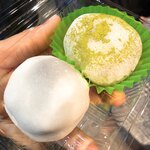











Details
Reservation Info
No Reservations
Payment Method
Credit cards accepted
Electronic Money Accepted
Private Dining Rooms
None
Smoking and Non-Smoking
No smoking at the table
Parking
None
Comments
(20)
idanbo
3.10
Near Matsubara Bridge, there is a branch of the traditional Japanese confectionery store "Kofukudo," which was founded in the first year of the Meiji era. I bought the Goshogiboshi Monaka (Benkei) (302 yen) at the Nishiki Market branch. This Japanese sweet won the "21st Prime Minister's Award" at the National Confectionery Exhibition. It is filled with carefully selected Tamba Dainagon azuki bean paste, overflowing generously in the monaka. The appearance is solid and it has a satisfying texture. They accept PayPay payments. If you liked the review, please follow the account and save the shop.


glot
3.70
They all looked so delicious that I had to resist buying everything. The smiley face dango is cute and the sauce is tasty. The black sugar flavored an warabi was the best. Everything was so delicious that I definitely want to try other items too.

ホクホク
3.80
When I went to Kyoto, I wanted to visit the Nishiki Market, which I had seen on TV a few times. I heard that the birthplace of Ito Jakuchu was near the entrance. Nishiki Market is a wonderful street and the kitchen of Kyoto. I was captivated by every shop. Once I entered this street, I went elsewhere and came back again. There was a crowd in front of this Japanese confectionery shop, so I decided to buy something. I purchased the "Gojo Giboshi Senbei" (249 yen) with a shelf life of about 5 days, which has won the Prime Minister's Award, so it already looks delicious. The Anko made with Tamba Dainagon adzuki beans shines and looks divine. It's similar to the "Seppuku Senbei" I had in Shinbashi before. Maybe? The slightly sweet taste is also nice. It's great that you can buy them individually. I wouldn't mind giving these out. When you go to Kyoto, you have to revisit this street...




こりす。
3.20
It's a dense red bean paste! Delicious but one is enough per person ( ◠‿◠ ) It's quite filling, but tasty. It was a heavy, but delicious, red bean paste*・゜゚・*:.。..。.:*・'(*゚▽゚*)'・*:.。. .。.:*・゜゚・*



もぐもぐばばち
3.50
Kofukudo at Nishiki Market. There were delicious Japanese sweets displayed at the storefront. I was tempted by various options but ended up buying a chestnut rice cake. It cost 184 yen including tax. Considering the touristy location of Nishiki Market, it felt very affordable. I enjoyed it right away at the storefront. The rice cake was delicious. And the flavor of the Shibu-gawa chestnut was amazing! Eating such elegant and delicious Japanese sweets while strolling around felt extravagant. It was a Japanese sweet that I would love to enjoy sitting down with a cup of delicious tea.



たいき
4.00
It had been a while since I could leisurely walk around Nishiki Market and take my time to look around. Honestly, I only just noticed there was a traditional Japanese sweets shop here for the first time. Perhaps it's because it's usually crowded and I don't pay much attention to my surroundings? Since I was heading to work, I avoided fresh sweets and opted for the dorayaki series instead. I finally tried it recently. It lasts longer, but the red bean paste had whole beans and was delicious. It was really tasty.

kenta-crv
2.40
Today I ate the Gyojogiboshi Senbei that I purchased when visiting Kyoto. Inside the senbei, there is an overflowing amount of sweet red bean paste, and the outside is coated beautifully. For those who love red bean paste, this might be a favorite taste, but personally, I feel that there is too much red bean paste, one bite is enough for me. If you love red bean paste, please give it a try.

atomu
3.50
In Nishiki Market, there is a wagashi (Japanese sweets) shop that sells unique souvenirs. They offer items like mochi with black beans instead of the usual red bean paste, which is quite distinctive. Among inbound tourists, strawberry daifuku is a popular choice. The restaurant also shares information through their Google posts.

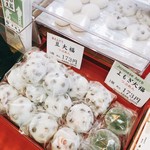


タツニイ
3.50
I used a coupon for sightseeing in Kyoto and stopped by Nishiki Market. I bought strawberry daifuku, ohagi, fu manju, and mandarin orange daifuku. There was one man and one woman working at the store, but their efficiency was surprisingly low, which made me feel sorry for the foreign tourists waiting behind me. The taste of all the sweets was subtly sweet and pleasing. The ohagi had grains of rice remaining, which gave it a good texture that I liked. The strawberry daifuku had strawberries on top, but personally, I prefer them inside the sweet bean paste. The mandarin orange daifuku had juicy mandarin oranges wrapped in a thin skin, and it was delicious as expected. The fu manju had a texture similar to kusa mochi, but with more elasticity, which I actually preferred, making it my favorite. Kyoto has many traditional Japanese sweet shops, and I imagine it must be tough to compete, but with a history dating back to the first year of the Meiji era, I hope they continue to thrive.

ボルシチ顎野郎
3.60
A crispy Monaka with a rich red bean paste filling! It has just the right amount of sweetness and goes well with bitter tea or coffee! Nishiki Market was crowded with tourists!

shima637
3.20
I was overwhelmed by the powerful presence of the Gojo Giboshi Senbei and decided to buy it as a souvenir. It's rare to see such a strong red bean paste flavor. The volume was surprising, but the sweetness was mild and enjoyable.


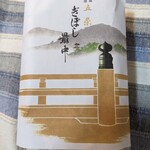

くま0622
3.30
I tried the Matcha Cream Daifuku with Azuki Beans for ¥200 and the Chestnut Mochi for ¥184. The combination of matcha cream and azuki beans was unexpectedly amazing. The balance with the mochi was perfect and the sweetness was just right. The Chestnut Mochi with chunks of chestnut was also delicious.

ぼんちゃん69
3.00




ChiCk
3.00

sayu21s
3.00



とみのぞ
3.50
Steamed Danbo chestnut daifuku @ 184 yen
構想記者
4.10
Usually I would never buy it, but because of summer fatigue and excessive hunger, I was completely in onigiri mode. The onigiri cost 150 yen, and I asked for a receipt. It had mountain vegetables, red rice, and rice balls. The sweetness of corn, carrots, and green peas was just right. The mountain vegetables were a last-minute addition, and the red rice was seasoned with a hint of salt, which complemented the mountain vegetables nicely. It was a delicious snack. The rice balls were still being sold in packs, and they were filled with whole beans, which was a nice touch. The rice balls were soft and chewy, just the way they should be.

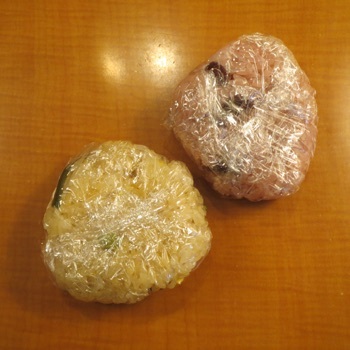
てくてくもぐもぐ
3.50
When I visit Kyoto, I always make sure to stop by Nishiki Market. This time, I went in the evening when many shops were starting to close. I found onigiri being sold at a shop that also had a variety of traditional Japanese sweets. I decided to get a red rice onigiri for 162 yen (tax included). I brought it back to my hotel and had it as a late-night snack. The onigiri wasn't tightly packed, but more loosely wrapped. It had a nice softness to it, which I really enjoyed. The red rice was delicious.

高くて旨いは当たり前
4.00
Exploring Nishiki Market is always a joy in Kyoto. Despite being considered somewhat commercialized, the sight of various "Kyoto foods" bustling in the narrow alleyways is truly a must-see. Lately, you can spot many foreign visitors as well. However, due to the nature of the place, you may not come across many authentic traditional Japanese sweets shops in Kyoto. "Kofukudo" is located in the middle of Nishiki Market. It is a Kyoto confectionery shop that offers affordable snacks, with its main store in Kawaramachi Matsubara. These types of shops are called "oman'yahan" in Kyoto. Every morning, freshly made treats are brought in from the main store in Matsubara. While the main store in Matsubara is quite large, the shop in Nishiki is very small with a narrow front for face-to-face sales. But the colorful half-finished sweets displayed in the glass showcase exude a truly Kyoto-like atmosphere. In line with Kyoto's spring, you can expect to see nightingale mochi, sakura mochi, and soon, kashiwa mochi. Whether it's mochi sweets or cute half-finished treats, the stunning color combinations are captivating, making you forget the crowds for a while. You may want to buy everything as a souvenir, but usually, I enjoy mochi sweets on the spot and then buy the shop's specialty, the "Giboshi-shaped Senbei," to take home. The "Mame Daifuku" (160 yen) is a cute, round daifuku with a solid weight when you hold it. The Hanejuu mochi made from Omi rice has a good rice aroma and stretchiness. The ample red azuki beans are cooked moist with just the right amount of saltiness and texture. The sweetness of the anko filling is exquisite. The "Giboshi Senbei" (230 yen) is a perfect souvenir for distant places as it keeps well. The senbei skin is shaped like the "Giboshi" found on the railing of the Gojo Ohashi Bridge, where the bond between Benkei and Yoshitsune (Ushiwakamaru) was formed. The origin of this Giboshi is said to be the "onion flower." The densely packed Tamba Adzuki bean paste is wrapped in a shiny transparent skin. The sweetness is firm but the flavor of the beans is prominent, making it feel rather restrained. It seems that people in Kyoto, known for their love of anko, enjoy this type of senbei. When in Kyoto, it's easy to be drawn to high-end wagashi shops. However, experiencing the seasonal ambiance rooted in daily life unique to oman'yasan like Kofukudo is an irresistible charm. It's affordable and full of everyday appeal. The main store near Matsubara Bridge has chairs and offers tea service, so I look forward to visiting and enjoying a chestnut red rice dish in a leisurely manner.

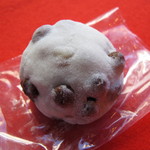


⭐︎ちえーる⭐︎
3.50
On the weekend, I went to Kyoto again for cherry blossom viewing! I stayed at a hotel near Karasuma Oike and bought various foods at Nishiki Market for a picnic by the Kamo River. For dessert after our meal, we bought strawberry daifuku from Kofuku-Do. I had been craving strawberry daifuku for a while, so I was finally able to enjoy it. We also bought orange daifuku, which was juicy, soft, and delicious. Although the orange daifuku was tasty, I still prefer strawberry daifuku.

Email Login